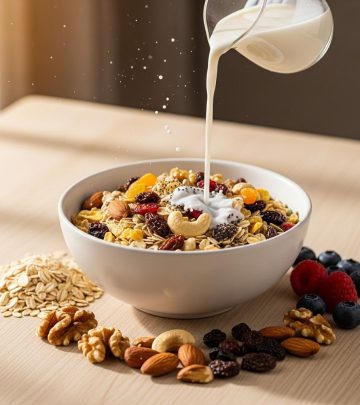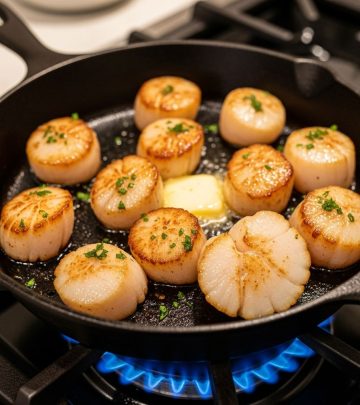Why You Should Never Throw Away Cauliflower Leaves
Discover the culinary, nutritional, and sustainable benefits of using every part of the cauliflower — leaves included.

Much like broccoli stems, beet greens, or carrot tops, cauliflower leaves are frequently discarded in the kitchen — a victim of habit, tradition, and sometimes pure convenience. But what if those leafy greens tucked protectively around your cauliflower head held tremendous flavor, nutrition, and culinary potential? Join the growing movement of root-to-stem eating and discover why you should be saving, savoring, and celebrating every part of your cauliflower, leaves included!
Understanding the Edibility and Value of Cauliflower Leaves
It may surprise some home cooks to learn that cauliflower leaves are entirely edible. Unlike the tough outer leaves of some vegetables, their pale green to deep green leaves cook down beautifully, offering a flavor and texture somewhere between collard greens and kale, with a hint of cauliflower’s distinct vegetal sweetness.
Why are they so often tossed away? Supermarkets and retailers often trim the leaves for cosmetic reasons, and many recipes don’t mention their use, contributing to a culture of food waste. However, food waste campaigns in Europe and the US are encouraging consumers and growers alike to embrace the versatility of these nutritious greens.
Nutrition Powerhouse: What’s Inside Cauliflower Leaves?
- Fiber – Supports healthy digestion and keeps you full.
- Vitamin C – One of the highest among common leafy greens, great for immunity.
- Vitamin A – Essential for vision, growth, and skin health.
- Folate – Crucial for cell growth and metabolic health.
- Calcium & Potassium – Beneficial for bone and heart health.
- Bioactive compounds like glucosinolates, phenolics, and flavonoids – deliver antioxidant and anti-inflammatory benefits.
Including these leaves in your meals boosts their nutritional profile, turning what’s often considered kitchen waste into a superfood addition.
The Taste and Texture of Cauliflower Leaves
When raw, cauliflower leaves can be a bit tough, making them ideal for cooking rather than salads—unless they’re very young and tender. Upon cooking, and especially when roasted, they become delightfully crispy and even a bit sweet, with a nutty undertone. Some liken the flavor to kale chips but with a subtler bite.
Stems, often attached to the leaves, soften during roasting or sautéing, taking on a mild, earthy note. Both parts are delicious, especially with bold seasonings or a squeeze of lemon.
Creative Ways to Use Cauliflower Leaves
Leave no part behind! Here’s how you can turn that pile of leaves into a rotation of vibrant dishes:
1. Roasted Cauliflower Leaves (Crispy ”Chips”)
Perhaps the easiest, most popular method. Roasting the leaves transforms them into crispy, savory snacks reminiscent of kale chips. Here’s how:
- Preheat oven to 425°F (220°C).
- Rinse, pat dry, and chop the leaves and stems into 1-inch pieces.
- Toss with olive oil, salt, pepper, and optional spices (paprika, garlic powder, chili flakes).
- Spread on a baking sheet.
- Roast for 10 minutes, toss, and roast until browned and crispy (about another 10 minutes).
- For added zest, squeeze lemon juice or sprinkle Parmesan right before serving.
Enjoy immediately as a healthy snack or vegetable side. The texture is delightfully shatter-crisp, and the flavor has hints of sweetness and nuttiness.
2. Cauliflower Leaf Pesto
Use the leaves as you would other greens to whip up a bright, robust pesto for pasta, pizza, or drizzling on roasted veggies:
- Combine blanched leaves, garlic, nuts (pine nuts, walnuts, or almonds), Parmesan, olive oil, and lemon in a food processor.
- Blend until smooth, then season to taste.
This pesto carries a pleasing herbaceousness and keeps the zero-waste spirit alive in your kitchen.
3. Stir-Fries and Sautéed Dishes
Substitute cauliflower leaves for any hearty greens in your stir-fry or sauté. Try them in Asian-inspired dishes with soy sauce, garlic, ginger, and sesame oil, or add to noodle and rice bowls for a boost of color and nutrients.
4. Green Soups and Stews
Chop the leaves and stalks and add them to soups, stews, or curries. They’ll soften beautifully while lending both bulk and a gentle flavor to your dish. They pair particularly well with coconut milk, lentils, and aromatics like coriander and cumin.
5. Salad Crunch Booster
Very young, tender cauliflower leaves can be shredded and tossed raw into salads, adding crunch and nutritional value. For tougher leaves, blanch briefly to soften before chopping into slaws or salad bowls.
6. Cauliflower Leaf Wraps
The larger, thicker leaves make excellent low-carb wraps. Blanch them in boiling water for a few seconds, then fill with rice, beans, lentil salad, or your favorite Greek-style fillings for a healthful hand-held meal.
Cauliflower Leaf Recipes to Try
Ready to put these ideas into practice? Here are a couple of beginner-friendly, crowd-pleasing recipes featuring cauliflower leaves front and center:
Roasted Cauliflower Leaves and Stems with Garlicky Dipping Sauce
- Ingredients:
– Leaves and stems from 1 cauliflower, chopped
– 2 tbsp olive oil
– 1/2 tsp kosher salt
– 1/4 tsp pepper
– Optional: paprika, lemon juice, fresh herbs
– For dipping sauce: 1/2 cup mayonnaise or Greek yogurt, 1 grated garlic clove, juice of 1 lemon, salt to taste - Method:
– Preheat oven to 425°F.
– Toss leaves and stems in oil, salt, and pepper.
– Roast for 10 minutes, flip, then roast for another 10 minutes or until crisp and browned.
– Mix sauce ingredients and serve as a dip alongside the roasted veggies. - Tips: Remove thinner leaves halfway to avoid burning. Add more flavor with grated Parmesan or chili flakes after roasting.
Cauliflower Leaf Stir-Fry
- Chicken thighs or tofu, chopped
- Cauliflower leaves
- Garlic, soy sauce, miso paste, carrots, and noodles
- Brown chicken or tofu, then add veggies and fry with sauce for a quick, satisfying dinner.
Other Ways to Use Cauliflower Leaves
- Blend into smoothies: Add a handful of tender leaves for a nutrition boost.
- Add to green juices: Alongside kale or spinach, cauliflower leaves blend well.
- Vegetable broth: Save leaves and stalks in your freezer and add to your next stock batch.
- Substitute for cabbage: Use in recipes that call for dark leafy greens—perfect in dishes like stuffed cabbage or dolmas.
Reducing Food Waste and Contributing to Sustainability
Using cauliflower leaves means not only wasting less but embracing a more sustainable approach to cooking and eating. Every part of the cauliflower—stems, leaves, core, and florets—can find a place on your plate. Root-to-stem cooking is a vital movement in the fight against food waste. Food waste campaigns, such as the “wonky fruit and veg” initiatives in the EU, are saving millions of tons of edible produce from landfill by encouraging the consumption of less-than-perfect produce and all edible parts.
Why Food Waste Matters
- Environmental Impact: Reducing waste conserves water, land, and resources used in growing and transporting produce.
- Economic Benefit: Using every part of vegetables saves money at home.
- Nutrition Maximization: Many of the leaves and stems have unique nutrients not as concentrated in the florets.
The History and Legacy of Cauliflower
Did you know cauliflower has an ancient pedigree, dating back to at least the sixth century BCE in the region now known as Syria? From the Mediterranean coast, it spread to Cyprus, France (where King Louis XIV famously adored it), and onward across the globe. Today, modern markets are beginning to recognize not just the beautiful central head but the entire plant as worthy of the table.
How to Store Cauliflower Leaves
To preserve freshness, store cauliflower leaves unwashed, in a plastic bag, in the crisper drawer of your refrigerator. They will keep for up to five days. Wash and dry thoroughly before use. If you have too many, chop and freeze to add later to soups, stews, or smoothies.
Common Questions about Cauliflower Leaves
Q: Are cauliflower leaves safe to eat?
A: Yes, they are safe and offer a wealth of nutritional benefits, including vitamins C, A, and minerals such as calcium and potassium.
Q: How do you prepare cauliflower leaves for cooking?
A: Wash thoroughly, pat dry, trim any tough ends, and chop. They can be roasted, sautéed, added to soups, or turned into pesto or wraps.
Q: Do cauliflower leaves taste like cabbage or kale?
A: Their flavor is slightly nutty, milder than kale, and with a hint of sweetness, especially when roasted.
Q: Can you freeze cauliflower leaves?
A: Yes, blanch, chop, and freeze in airtight containers. They work well in soups and stews after thawing.
Q: Are there cultural traditions for using cauliflower leaves?
A: While not common in many Western recipes, in certain South Asian curries and African stews, the leaves are a traditional ingredient. In the UK, trends toward zero waste and “wonky veg” campaigns are boosting their revival.
Comparison Table: Cauliflower Florets vs. Leaves vs. Stems
| Part | Flavor | Texture | Best Uses | Key Nutrients |
|---|---|---|---|---|
| Florets | Mild, sweet, buttery | Tender | Roasting, steaming, soups, mashing | Vitamin C, K, B vitamins |
| Leaves | Nutty, slightly sweet, leafy | Crispy (roasted), soft (sautéed) | Chips, stir-fry, wraps, pesto | Vitamin C, A, calcium, fiber |
| Stems | Mild, a bit earthy | Firm but tender when cooked | Soups, stir-fry, slaw, pickling | Fiber, potassium, B vitamins |
Final Thoughts and Cooking Inspiration
By making the most of cauliflower leaves, you transform your cooking, boost your nutrition, and make a real difference in reducing food waste. Next time you bring home a head of cauliflower, look beyond the white florets — the leaves and stems are just as delicious, and perhaps the tastiest secret of all.
Frequently Asked Questions (FAQs)
Q: What’s the easiest way to start cooking with cauliflower leaves?
A: Start by roasting them! Toss with olive oil and salt, bake until crispy, and snack away like you would with kale chips.
Q: Can I use cauliflower leaves just like kale or chard?
A: Yes; substitute in most cooked green recipes, though they tend to be more delicate. Adjust cooking time accordingly.
Q: Are there any recipes where cauliflower leaves don’t work?
A: Leave them out of delicate fresh salads unless using the smallest, tender inside leaves. For most other dishes—from curries to sautés—they shine.
Q: How can I encourage kids to eat cauliflower leaves?
A: Roast them for chips or add to pesto; the mild flavor and crispy texture are usually a hit.
Q: What should I do if my store trims off most of the leaves?
A: Seek out local farmers’ markets where heads are often sold intact, or ask your grocer to save the leaves for you. Sometimes a friendly request is all it takes!












